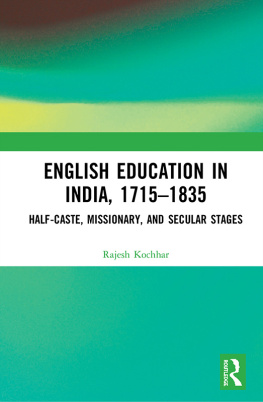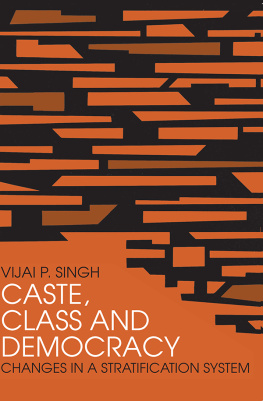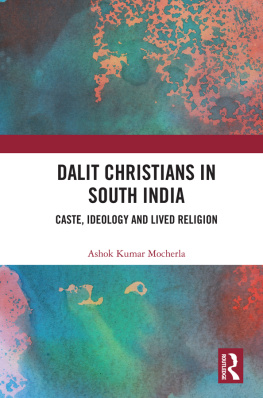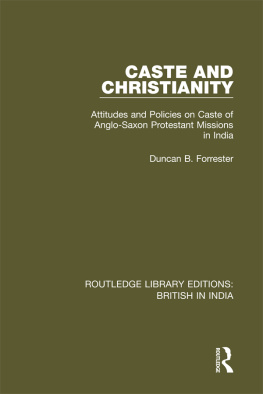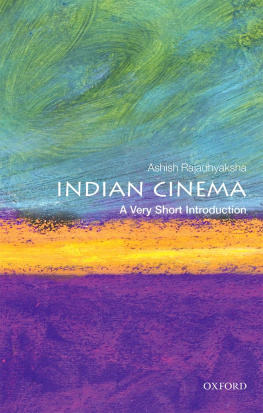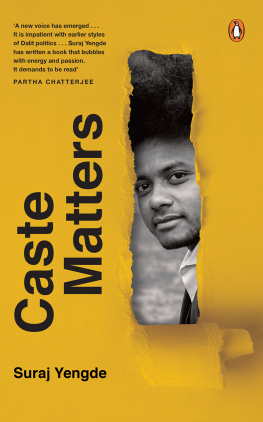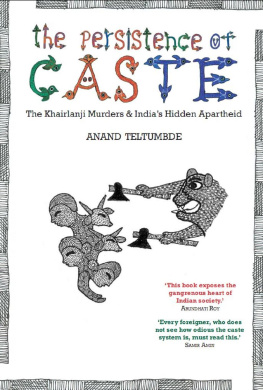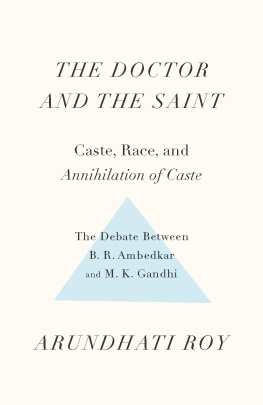English Education in India, 17151835
This book identifies and describes the first stage in the advent and growth of English education in India. The first schools in India were the charity schools, asylums, and orphanages openedz under the auspices of the Church of England for religious instruction, training, and care of half-caste or mixed-race children the progeny of Protestant fathers from Indian women. It examines the influence of the half-caste community and the missionaries on the growing Indian demand for English education and opportunities for employment.
The well-entrenched scenarios on the pre-history of Hindoo College Calcutta are re-examined in the light of new evidence discussed here for the first time. The book further analyses the shifts in the educational policies by the British colonial administrators and the interventions by the likes of Trevelyan, Macaulay, and Bentinck.
Detailed and insightful, this volume will be of great interest to students and researchers of history, literature, postcolonial studies, cultural studies, colonial expansion, and South Asian studies.
Rajesh Kochhar is Honorary Professor, Panjab University, India. An astrophysicist turned historian, he has published original research with a special focus on the history of science and education in British India. He has been the Director of the National Institute of Science, Technology and Development Studies (CSIR) in New Delhi and Professor at the Indian Institute of Astrophysics in Bangalore.
First published 2021
by Routledge
2 Park Square, Milton Park, Abingdon, Oxon OX14 4RN
by Routledge
52 Vanderbilt Avenue, New York, NY 10017
Routledge is an imprint of the Taylor & Francis Group, an informa business
2021 Rajesh Kochhar
The right of Rajesh Kochhar to be identified as author of this work has been asserted by him in accordance with sections 77 and 78 of the Copyright, Designs and Patents Act 1988.
All rights reserved. No part of this book may be reprinted or reproduced or utilised in any form or by any electronic, mechanical, or other means, now known or hereafter invented, including photocopying and recording, or in any information storage or retrieval system, without permission in writing from the publishers.
Trademark notice: Product or corporate names may be trademarks or registered trademarks, and are used only for identification and explanation without intent to infringe.
British Library Cataloguing in Publication Data
A catalogue record for this book is available from the British Library
Library of Congress Cataloging-in-Publication Data
A catalog record has been requested for this book
ISBN: 978-0-367-32263-2 (hbk)
ISBN: 978-0-429-31761-3 (ebk)
Typeset in Sabon
by Taylor & Francis Books
Contents
I thank Valerie Anderson, Maureen Evers, Mary Kay Hemenway, Daniel Jeyraj, Krishna Kumar, Harry MacLure, Pyare Mohan, AlokMukerjee, Arun P. Mukherjee, and Richard O'Connor for useful conversations, critical comments, help with bibliographical material, and general support. I thank Amit Kumar in particular for facilitating my contact with Routledge, and I am grateful to Routledges editors, referees, and staff for their valuable help.
India was an advantageous country for the British to own, but its people could not be wished away. The East India Companys rule in India was arguably the most bizarre experiment in governance that the world has ever seen. The new rulers knew nothing about the land or the peoples now under their control. The locals spoke a different language and followed a different religion. As a first step, the colonists became patrons of ancient learning, with a view to endearing themselves to influential sections of Hindu society. The British had no option but to employ Indians in the administration of their own country by teaching them English or, as the colonists put it, by effecting their moral and intellectual improvement. But the timing had to be chosen carefully. Lower castes never became part of the discourse, while the Muslim population would enter it reluctantly only after the Mughal dynasty fell from power.
The Charter Act of 1813 permitted British Christian missionaries to operate freely in the East India Companys Indian territories. There were already a few missionaries in India, but they were dissenters rather than mainstream, had arrived clandestinely, made themselves inconspicuous by working in the mofussil (the regions of India outside the three East India Company capitals of Bombay, Calcutta and Madras), and safely set up their headquarters in Dutch or Danish sovereign enclaves. Post-1813 Anglican and other missionaries could work from stations of their choice and receive help from officials. The missionaries as a class were welleducated, intellectually gifted, hard-working and dedicated. They learnt Sanskrit and other languages, extracted vernacular grammars from actual usage, compiled bilingual dictionaries, developed prose style, and set up printing facilities. The government had many occasions to draw on their help. However, they were strictly forbidden from indulging in any activity that would damage the governments non-religious credentials and lead to civil or political unrest. The missionaries were free to open schools to convince the pupils that Christianity was the true religion. These schools became very popular. Such was the desire among young men in lower Bengal to learn a little English to be able to obtain employment that they had no objection to its being packaged with Christian scriptures.
The popularity of missionary-run, Christianity-laden English education alarmed Hindus and propelled them to open their own school in Calcutta. The significance of Hindoo College, which began functioning in January 1817 was immediately noticed. A chaplain, Reverend T. T. Thomason wrote in his diary: Such was the origin and consummation of a work which will form an epoch in Indian history. Similarly, at the opening of the College, A learned Native expressed his hope that Hindoo College would resemble the Bur [Bargad, banyan], the largest of trees, which yet is at first but a small seedling. Hindoo College was seen as a welcome and long-awaited demonstration of the willingness of the leading members of the majority community to co-operate with the new rulers. Even though it was meant for Hindus alone and, that too, of the respectable kind, it was liberally supported by the government. It became a role model for later schools.
Contrary to popular perception, English education began in India not on the grounds of religion or administration but genetics; and not on directions from the British Parliament but in consultation with the Anglican Church. The earliest English language classrooms were set up in the church with help from the government for the education and care of half-caste or Eurasian children the progeny of Protestant fathers from local women. In most cases, the father was either dead, back in England or unconcerned. Even when there were stable mixed-race families, the government considered it its duty to save half-castes from the viciousness of the mother and her side. Recent years have seen attempts at the romanticization of mixed-race unions, but this is clearly anachronistic. Current scholarship has taken note of the half-caste phenomenon from the 1780s onwards in sociological and family contexts rather than educational. Even though half-caste education was largely self-contained, it influenced later developments. The ease with which educated Eurasians found jobs built a demand for English education among Hindus. At the same time, the availability of Eurasian teachers on low salaries compared with the Europeans made new English schools cost-effective and popular. Many of todays prestigious and expensive public schools in India began life as charity schools, asylums, and orphanages.

